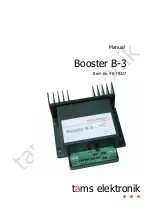
UMX-OPT-TX150R
User’s Manual
Section 2. General description
Page 13 / 107
2.6. Advanced EDID Management
Each DVI sink (e.g. monitors, projectors, plasma displays, and switcher inputs) must
support the EDID data structure. Source BIOS and operating systems are likely to query
the sink using DDC2B protocol to determine what pixel formats and interface are
supported. HDMI standard makes use of EDID data structure for the identification of the
monitor type and capabilities. Most DVI sources (graphic cards, set top boxes, etc.) will
output DVI signal after accepting the connected
sink’s EDID information. In case of EDID
readout failure or missing EDID the source will not output DVI video signal.
UMX-OPT-TX150R
provides Lightware’s Advanced EDID Management function that
helps system integration. The built in EDID Router stores and emulates 36 EDID data
plus all monitor's EDID that are connected to the output connectors. There are 20 factory
preset and 16 user programmable EDIDs. The router stores the EDID of all attached
monitors or projectors for the output in a non-volatile memory. This way the EDID from a
monitor is available when the monitor is unplugged, or switched off.
An emulated EDID can be copied from the EDID router's memory (static EDID
emulation), or from the last attached monitors memory (dynamic EDID emulation). For
example, the router can be set up to emulate a device, which is connected to the output.
In this case the EDID automatically changes, if the monitor is replaced with another
display device (as long as it has a valid EDID).
EDID is independently programmable for all inputs without affecting each other. All inputs
have their own EDID circuit. EDID Router can be controlled via USB or serial port.
Info:
The user is not required to disconnect the video cables to change an EDID as opposed to
other manufacturer’s products. EDID can be changed even if a source is connected to the
input and it is powered ON.
Info:
When EDID has been changed, the unit toggles the HOTPLUG signal for 2 seconds.
Some sources do not observe this signal, so in this case the change is not recognized by
the source. In such cases the source device must be restarted or powered OFF and ON
again.
2.7. HDCP management
Lightware Visual Engineering is a legal HDCP adopter, and has developed several
functions that helps to solve HDCP related problems.
2.7.1. HDPC key caching
Lightware introduced the HDCP key cashing technique in early 2009 that validates all the
display keys in an AV system during system boot up and keeps them constantly available
for sources. This method eliminates the HDCP handshake at every switch and keeps all
sources sending uninterrupted signals.
Without this function the sources should re-authenticate HDCP after each crosspoint
switch which makes the displays to drop the signal and go black for 5-8 seconds. The
HDCP key cashing technique avoids this and allows instantaneous switching between
two encrypted signals.
2.7.2. Avoiding unnecessary HDCP encryption
Many video sources send HDCP protected signal if they detect that the sink is HDCP
capable
– even if the content is not copyrighted. This can cause trouble if a HDCP
capable device (e.g. repeater or matrix router) is connected between the source and the
display. In this case the content can’t be viewed on non-HDCP capable displays and
interfaces like event controllers.
Rental and staging technicians often complain about Apple laptops, who always send
HDCP encrypted signals if the receiver device (display, matrix router, etc.) reports HDCP
compliancy. However HDCP encryption is not required all the time (e.g. computer
desktop image) MacBook and MacBookPro still do that.
Summary of Contents for UMX-OPT-TX150R
Page 1: ...UMX OPT TX150R User s Manual ...
Page 2: ......














































